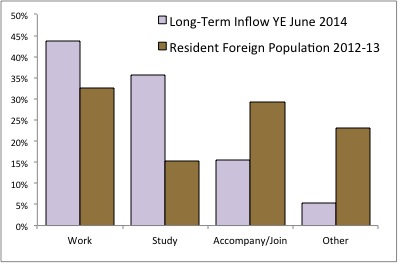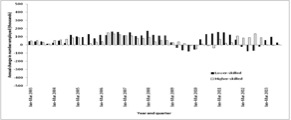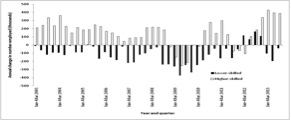The March COMPAS Breakfast Briefing was presented by Jon Simmons, who leads the migration research at the UK Home Office. He presented three important recent Home Office Science reports on migrants into the UK.
Skills and employment
The first report, Employment and occupational skill levels among UK and foreign nationals (published last February), provides valuable insights into migrants and non-migrants in the jobs market. Based on Labour Force Survey (LFS) data – analysed by nationality, rather than country of birth, because the former affects right to work – the report shows trends in the labour market in the recent period.
For example, the analysis shows that after a long period of rising employment in the late 1990s and early 2000s that mainly benefited UK nationals, after EU8 accession the rise in employment continued to rise but with three quarters of this now accounted for by foreign nationals. Before EU8 accession, there had been a big gap between the employment rate of UK nationals and foreign nationals; this gap shrunk after accession. When the recession hit, employment dropped steeply among UK nationals rather than foreign workers – but during the recovery UK nationals have accounted for a new rise in employment rates.
Reasons to come and reasons to stay
The second report, The reason for migration and labour market characteristics of UK residents born abroad (published in September), uses a new question (coded WHYUK) that the Home Office have commissioned from the Labour Force Survey to look at the population born abroad by immigration route. This shows that family migrants now represent a very significant percentage of the UK’s resident migrant population (41% either came as a dependent of another migrant or to join someone resident here – compared to 26% who came to work). Placing this data on migrant “stocks” next to the International Passenger Survey data on migrant “flows” is striking: far more people come here every year to work or study than to join family members, but it is the latter who stay.

Source: ONS Long-term International Migration (LTIM) and HO research report ‘The Reason for migration and labour market characteristics of UK residents born abroad’ (2014)
Jon also showed how these patterns vary by country of origin. In general, for non-European migrants, family is even more prominent compared to work as the reason for migrating. Bangladeshi-, German-, Pakistani- and to a lesser extent Indian- and Irish-born residents are especially likely to have come for family reasons. Student migration was most prominent among the Nigerian-born and, to a lesser extent, US- and Indian-born, while work was most prominent among Latvian-, Lithuanian- and Polish-born residents.
The data also shows how the immigration route makes a difference to labour market outcomes: not surprisingly, work migrants have extremely high employment rates, while family migrants and refugees have low employment rates. The employment rates, however, can mask the types of jobs people are doing. Non-European migrants who work, including those who come as dependents, are generally in higher skill, higher paid jobs – while European migrants, including those who came as dependants, end up in low skill, low paid jobs.
Convergence over time
The third report, conducted with the Office for National Statistics, Social and Economic Characteristics by Length of Residence of Migrant Populations in England and Wales (published in September and based on detailed analysis of the 2011 Census), reveals some key features of newer and longer term migrants, and degree to which people coming from abroad retain their difference, whether through cultural effects or long-term disadvantage, and the degree to which they become more like the population of which they have come to be a part.
Jon’s presentation looked at this question in a series of domains: economic activity, housing tenure, language proficiency, national identity and naturalisation. In terms of economic activity, migrant outcomes converge over time with those of the UK-born. Newly arrived EU migrants are much more likely to be employed than UK-born and non-EU migrants are much less likely, but these gaps rapidly start to close after five years and eventually disappear. Similarly, newly arrived migrants are concentrated in the private rented sector and locked out of owner occupation and social housing but eventually overtake the UK-born in the owner-occupied sector. Unsurprisingly, longer term migrants become proficient in English, identify as British and become citizens.
However, Jon also showed that there are big variations to the picture when you look by country of origin. For example, Bangladeshi- and Pakistani-born people are less likely to catch up the labour market and in English language, but more likely to catch up in the housing market and most likely to identify with Britishness. Irish-born migrants are very likely to become owner-occupiers, but very unlikely to identify with Britishness or to naturalise.
The immigration debate
You can look at Jon’s powerpoint slides here. In the rest of this blogpost, I want to reflect briefly on what this data tells us, and in particular on how it might affect some key debates in our field.
The perception debate
There is a growing body of evidence that the public think differently about the migration debate when they think about different groups of migrants. For example, Migration Observatory polling data shows that more people want to reduce permanent migration than temporary migration – but more people want to reduce low-skilled migration rather than high-skilled migration. If the public knew that temporary migrants are more likely to be in low- skilled jobs while long-term migrants are more likely to be in high-skilled jobs, would changed perceptions lead to changed views on reducing the numbers?
The family debate
As the Points-Based system, tightening of the asylum system and restrictions on student migration have kicked in, family migration has become a particularly heated area of the immigration debate. Family migrants have borne the brunt of many of the most dramatic recent changes to immigration law. We know that the public’s view of family migration is conflicted: a minority want to reduce the immigration of immediate family members, but a majority want to reduce the immigration of extended family members. Would a clearer picture of family migrants, as provided by Jon’s data, make a difference to this debate? In fact, is it politically toxic to highlight family migration at all?
The skills debate
Labour migration has been an even more heated topic than family migration. This week, UKIP announced new policies to keep low-skilled migrants out, pointing to the detrimental impact on “working class jobs”. The data which Jon presented shows how complex this issue is. Before EU8 Accession, a larger proportion of foreign nationals were in higher-skilled jobs than citizens; after 2005, that trend reversed. A growing proportion of foreign nationals have been in low-skilled jobs, and even before recession UK nationals were being lost in low-skilled occupations. This gives some weight to the UKIP argument about labour migrants competing for these jobs.
But, strikingly, UK nationals’ employment in high-skilled jobs increased in the post-accession period and has dramatically increased in the post-recession recovery. This suggests that migrant labour being directed into low-skilled occupations may have a less straightforward effect than the UKIP narrative suggests. The debate about skills needs to engage more closely with the debate on immigration – but both need to attend more closely to the evidence.
The integration debate
Finally, the data Jon presented contributes to our understanding of the integration debate, one of the most emotive parts of the migration debate. The census analysis shows clearly that integration is not a single process that unfolds in a linear way for everyone. This is true for at least two reasons.
First, the changing situation in the country of settlement makes a difference to the possibility of integration: housing market integration is different for the Windrush generation, who faced explicit racism but benefited from more abundant supply of housing, than for migrants in Generation Rent, who might not experience overt discrimination by are locked out of owner occupation for other reasons. Similarly, the rights and entitlements available legally – for instance to social housing allocation, to benefits, to naturalisation – change over time, changing the context in which migrants struggle to integrate.
Second, as Sarah Spencer and I have argued elsewhere, integration in one domain is related to integration in other domains but never straightforwardly. Integration in the labour market may or may not map on to a sense of national belonging, for example.
A more multi-dimensional picture of integration as it happens is vital for a more healthy integration debate, just as a more evidence-based picture of family migration and of competition in the labour market is vital for a more healthy debate on immigration restriction.


